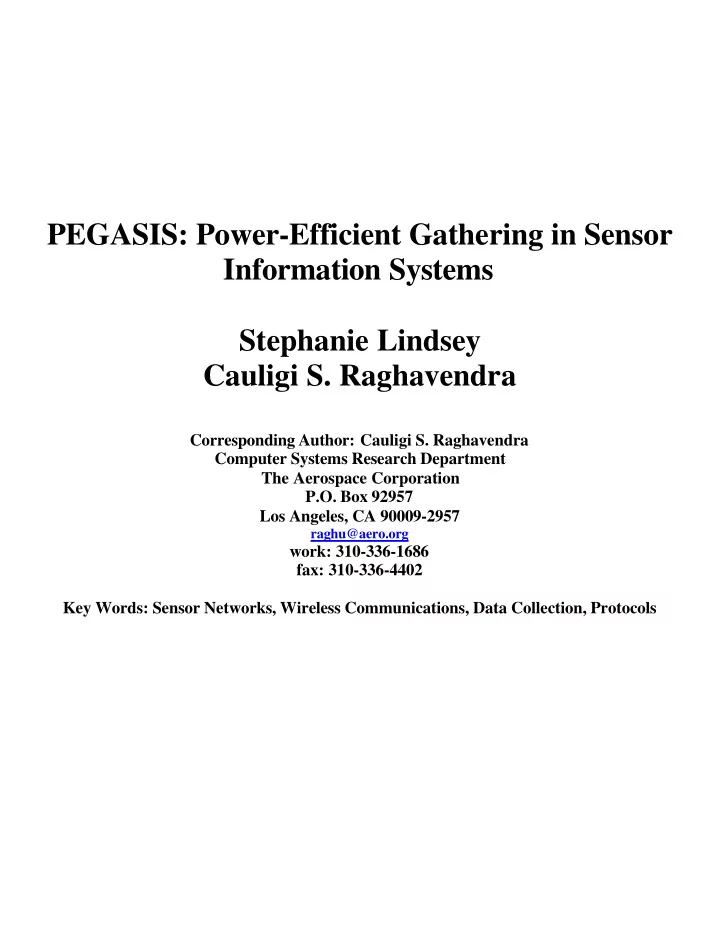

PEGASIS: Power-Efficient Gathering in Sensor Information Systems Stephanie Lindsey Cauligi S. Raghavendra Corresponding Author: Cauligi S. Raghavendra Computer Systems Research Department The Aerospace Corporation P.O. Box 92957 Los Angeles, CA 90009-2957 raghu@aero.org work: 310-336-1686 fax: 310-336-4402 Key Words: Sensor Networks, Wireless Communications, Data Collection, Protocols
S. Lindsey PEGASIS: Power-Efficient Gathering in Sensor Information Systems PEGASIS: Power-Efficient GAthering in Sensor Information Systems Stephanie Lindsey and Cauligi S. Raghavendra Computer Systems Research Department The Aerospace Corporation P. O. Box 92957 Los Angeles, CA 90009-2957 Abstract consumption by using local collaboration among the nodes, and tolerate node failures [14]. Figure 1 shows a 100-node sensor network in a play field of Sensor webs consisting of nodes with limited battery size 50m x 50m. A typical application in a sensor web is power and wireless communications are deployed to collect gathering of sensed data at a distant base station (BS) [3]. useful information from the field. Gathering sensed Each sensor node has power control and the ability to transmit information in an energy efficient manner is critical to data to any other sensor node or directly to the BS [6,7]. We operate the sensor network for a long period of time. In [3] assume that all nodes have location information about all other a data collection problem is defined where, in a round of nodes. However, if this were not the case, our scheme would communication, each sensor node has a packet to be sent still work. Nodes would have to expend some extra energy to to the distant base station. If each node transmits its sensed find their close neighbors. They could do this by sending with data directly to the base station then it will deplete its enough power to signal a node, and then gradually reduce its power quickly. The LEACH protocol presented in [3] is an power to find which neighbor is closest to it. In this paper, our elegant solution where clusters are formed to fuse data model sensor network has the following properties: before transmitting to the base station. By randomizing the cluster heads chosen to transmit to the base station, • The BS is fixed at a far distance from the sensor nodes. LEACH achieves a factor of 8 improvement compared to • The sensor nodes are homogeneous and energy direct transmissions, as measured in terms of when nodes constrained with uniform energy. die. In this paper, we propose PEGASIS (Power-Efficient • No mobility of sensor nodes. GAthering in Sensor Information Systems), a near optimal chain-based protocol that is an improvement over Figure 1 . Random 100-node topology for a 50m x 50m LEACH. In PEGASIS, each node communicates only with network. BS is located at (25, 150), which is at least 100m a close neighbor and takes turns transmitting to the base station, thus reducing the amount of energy spent per 50 round. Simulation results show that PEGASIS performs 45 better than LEACH by about 100 to 300% when 1%, 20%, 40 50% , and 100% of nodes die for different network sizes Y-coordinates 35 and topologies. 30 1. Introduction 25 20 15 Inexpensive sensors capable of significant computation and 10 wireless communications are becoming available [2,4]. A web of sensor nodes can be deployed to collect useful information 5 from the field, for example, in harsh physical environments 0 [13]. These sensor nodes collect audio, seismic, and other 0 10 20 30 40 50 types of data and collaborate to perform a high level task in X-coordinates the network. Sensor nodes are severely constrained by the from the nearest node. amount of battery power available, limiting the lifetime and quality of the network. Since wireless communications In each round of this data-gathering application, all data consume significant amounts of battery power, sensor nodes from all nodes need to be collected and transmitted to the BS, should spend as little energy as possible receiving and where the end-user can access the data. A simple approach to transmitting data [5,10,12]. It is necessary for communication accomplish this task is for each node to transmit its data protocols to maximize nodes’ lifetimes [9], reduce bandwidth 1
Recommend
More recommend